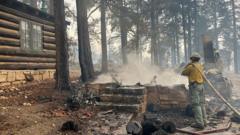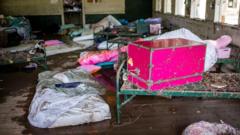An alarming wave of wildfires in Canada's prairies has forced thousands to evacuate and prompted states of emergency, with smoke affecting air quality as far south as the United States.**
Catastrophic Wildfires Devastate Canadian Prairies, Impacting Air Quality Across Borders**

Catastrophic Wildfires Devastate Canadian Prairies, Impacting Air Quality Across Borders**
Thousands have evacuated as wildfires in Saskatchewan and Manitoba rage on, causing deteriorating air quality in parts of the U.S. Midwest.**
The Canadian provinces of Saskatchewan and Manitoba are grappling with a series of catastrophic wildfires that have led to large-scale evacuations and serious air quality issues across the U.S. Midwest. As of May 31, 2025, approximately 1.7 million acres have been engulfed in flames, prompting officials to declare states of emergency across the hard-hit areas. Many residents, including those from First Nations reserves, have been forced to flee their homes, with the Canadian armed forces aiding evacuation efforts due to perilous conditions.
The severity of the fires, particularly in north Manitoba near the Saskatchewan border and in northern Saskatchewan itself, has already resulted in tragic fatalities, including the deaths of two individuals caused by the flames in a small town in Manitoba. Premier Wab Kinew of Manitoba has indicated that around 17,000 residents have been ordered to evacuate, and this number may rise as fire conditions remain volatile.
As the smoke keeps billowing southward, states like Michigan, Minnesota, and Wisconsin are feeling the effects, with air quality deteriorating rapidly. Minnesota’s Pollution Control Agency has warned that this smoky haze is expected to linger through the first week of June, compounding the already precarious situation. The wildfires are challenging for firefighting crews, especially given the rugged terrain and limited access to some fire-prone areas. With Canada's wildfire season typically spanning from March to October, the situation raises concerns about what this summer may hold as the region continues to combat and contain the flames.
The severity of the fires, particularly in north Manitoba near the Saskatchewan border and in northern Saskatchewan itself, has already resulted in tragic fatalities, including the deaths of two individuals caused by the flames in a small town in Manitoba. Premier Wab Kinew of Manitoba has indicated that around 17,000 residents have been ordered to evacuate, and this number may rise as fire conditions remain volatile.
As the smoke keeps billowing southward, states like Michigan, Minnesota, and Wisconsin are feeling the effects, with air quality deteriorating rapidly. Minnesota’s Pollution Control Agency has warned that this smoky haze is expected to linger through the first week of June, compounding the already precarious situation. The wildfires are challenging for firefighting crews, especially given the rugged terrain and limited access to some fire-prone areas. With Canada's wildfire season typically spanning from March to October, the situation raises concerns about what this summer may hold as the region continues to combat and contain the flames.



















